
A note from David Jaggard: On the ever-lengthening list of events being canceled due to the COVID-19 pandemic, one of the most lamented is the Salon de l’Agriculture, France’s annual (and possibly the world’s largest) farm fair. So we can’t go marvel at the size of the bulls and boars on display or revel in the variety of foods and wines on sale. In the meantime, Paris Update offers a vicarious visit to the Salon from the C’est Ironique archives. This article was originally published in 2011.
The Salon de l’Agriculture, France’s annual farm and food fair, is a celebration of authenticity. Upholding the timeless values of devotion to artisanal quality and respect for tradition, farmers, winegrowers and producers of every kind of foodstuff from all over the country converge on the Paris Expo exhibition center every February to showcase their finest, most creative, lovingly prepared natural products in a veritable cornucopia of genuine, bona fide goodness.
So, naturally, the first thing you see when you emerge from the Métro at Porte de Versailles is a herd of scalpers hawking counterfeit, stolen and/or overpriced tickets. The lines at the ticket windows can get long — more than 650,000 people went to last year’s salon — so reselling the €12 tickets (€6 for children) has become what I suppose you could call an outhouse industry.
Not surprisingly, the general expectation is that anyone brandishing a ticket outside the gates is dishonest, as I learned when I went on opening day last Saturday (closing day is Sunday, February 27). I happened to have an extra invitation and figured I would be a nice guy and nicely give it away for free to some nice-looking person. Wouldn’t that be nice?
Apparently not, because as I was trying to explain this to a not-very-affluent-looking woman with three kids waiting in the ticket line, a guy – not a security guard, not a salon employee, not anyone the woman knew, just a guy – strode briskly over and brusquely snatched the invitation out of my hands. He examined it very closely, scowling as though it were a hidden camera photo of his daughter in the shower, and then handed it brusquely back.
Meanwhile, the woman was gawping at me as if I had asked her to trade the ticket for one of her kids. But she finally accepted it, and as I walked away she switched her disbelieving stare from me to the invitation. Adding to the strangeness of the scene, no one but me uttered a single word during this entire interaction.
So the bona fide goodness doesn’t actually start until you get inside. Being an orderly kind of person, I began with Pavilion 1, the livestock show. Inside, the atmosphere of authenticity was so thick you could cut it with a chainsaw and stack it in cords for next winter: since the building is converted for the duration of the salon into the mother of all cow, goat, sheep and hog barns, the parts per million of manure in the air was in a range of figures normally associated with the U.S. federal budget deficit.
Personally, I prefer my livestock subdivided, cooked and paired with something from the liver-impairing beverages group, but I found it rather interesting, despite the aroma, to see just how big a bull, a boar or even a rabbit can get. And how E.T.-freakish-looking some of the lesser-known breeds of chicken can be. Plus I learned something: only bovines get names. None of the sheep or goats, but all of the cows and bulls have little ID sheets at the head of their stalls showing their names.
Apparently it’s the practice among cattle breeders to give calves born in the same year evocative names beginning with the same letter. Receiving visitors at this year’s salon are a brace of milk cows with monikers that translate as Elegant, Enchanted, Affronted (it’s an “E” in French), Enlightened and Edelweiss.
Among their elders are cows named Disney, Candy, Bugatti and a silo-sized Charolais bull named Alcapone, who did indeed look as though he would have no compunctions about committing tax evasion. And from the previous run through the alphabet, there were no fewer than three cows from the “U” year named Unique. Clones, presumably.

By the time I had made the rounds of the straw heaps, it was well past noon and I was getting hungry. Rather than follow the example of the surprising number of people happily munching away on sandwiches and ice-cream cones in the midst of the methane miasma, I decided to get out of there and head for the food displays.
I checked the map and discovered that Pavilion 2 houses the plants and garden equipment, Pavilion 4 is the dog and pony show (really) and the food products are in Pavilions 3 and 7. There’s nothing in 5 or 6, which I assume were last year’s livestock spaces, still closed for shoveling.
I went first to Pavilion 3, which houses the foreign food stands. As I knew from previous years, a lot of exhibitors at the Salon de l’Agriculture offer sandwiches featuring their prize ingredients, and I was determined to find an outstanding sandwich for my stand-up lunch. The first temptation I encountered was the Tuscan stand (aisle D toward the back), which was doing a brisk business in porchetta.
(Note: Throughout this report, I mention every stand number I can. A missing stand number means that it wasn’t marked, is impossible to find on the poorly engineered SdA Web site, and the exhibitors themselves couldn’t tell me. This was far more common than you might expect.)
The Italians had decided to go whole hog. Literally. Several intact roasted pig carcasses, lying in state snout to tail, were being sliced up and served on bread, along with industrial-sized salamis and mortadellas that John Deere could use to level asphalt.
This looked good, but I ended up succumbing to the simmered Serrano ham, onion and tomato sandwich at the Basque stand at the end of the aisle, largely because it also has a bar where I could get counter space — a sublettable luxury in the jam-packed corridors of the salon — and a Basque beer (total €10).

It was good, but I had forgotten the First Immutable Universal Law of Food Fairs, a principle hypothesized by Ptolemy and later proven by Sir Isaac Newton: whenever you buy something that looks good, as soon as you turn around you’re going to see a similar product that looks even better.
In this case, after polishing off my ham roll I turned around to see the hot lunch on offer at La Gazelle d’Or, the Moroccan stand across the aisle (3 E 112). They had two women rolling out what I would call flatbread but what they called crêpes, cooking them on a griddle and filling them with a sautéed, sauce-intensive chicken-chunk-and-onion mix redolent with spices that Pavlov could have used to falsify his results. I made a mental note to come back later and try one.
Then my mental notebook slammed shut when I turned around again and saw a guy in an apron picking his way through the crowd toting a huge platter heaped with long, stout skewers holding various kinds of chops and links. It looked so good I followed him to see which stand he was supplying. Despite the size of the platter, I lost him in the crowd, but I recognized the meat at the Brazilian eatery, Churrascaria Brasileira.
Again, the stand number remains a mystery, but you can’t miss it because it’s in Pavilion 3 at the end of aisles B and C and is marked by a Brazilian flag only slightly smaller than Brazil itself. Here you can sit down at an actual table, with plates and forks and everything, and order poisson et viande à volonté — all the meat and fish you can eat.
But my stomach was full and it was time to have a look at the French food across the lane in Pavilion 7, whose two levels are divided by region. I decided to start upstairs and work my way down. I picked up some tome and chèvre cheese at the Boutique du Concours Général Agricole, which groups together all of the salon’s prize-winning foods (to the right of the main entrance on 7.2), some red Camargue rice, and some herbed-up boudin and a bacon-and-filet pork roll at the stand of a charcuterie called Au Porc d’Attache, a terrible franco-pun that is frankly not worth explaining.
They also had a tastebud-friendly-looking product called an “andouillette blanche,” but since andouillette is usually a grayish-brown pork tripe sausage (in other words, a piece of pig gut filled with pieces of pig guts) that smells, and therefore tastes, like it has been rolling around on the floor of Pavilion 1 since before Alcapone was born, I figured that making it white wasn’t going to make it any more appetizing, so I gave it a miss.
At the other end of the hall, I noticed another very good-looking sandwich that I was too full to try: hot chunks of meaty sausage cooked with peppers at Casa Corsa in the Corsican section (7.2 A 58).
Downstairs, I bought some duck components, including gizzards and foie gras, from Yvette Vaubrat (7.1 F 47) and then, having walked off a bit of my lunch, opted to have some oysters. The Christine Badets stand at 7.1 L 42 offers nine of the small-gauge kind plus a glass of wine for €14. I’m not complaining about the size: when it comes to oysters, small is often better.
You want an oyster to be a bite-sized morsel, and a really big one is hard to chew — it’s virtually impossible to bite one neatly in half — and, worse, with the giant ones you start to discern the critter’s different internal organs, digestive tract, its contents, etc., which may be of interest to a marine biologist but not to the seafood enthusiast. When eating a meal, you never want to be reminded of your meal’s last meal.
By this point it was after five o’clock, which I figured was close enough to dinnertime to try the Moroccan sandwich. On my way back through Pavilion 3, I stopped off at the Hungarian stand (3 B 108-110). Hungary, a new exhibitor this year, has set up a little store with an array of very attractive products at very attractive prices.
You can get a whole (italics mine) duck foie gras for €22 to €25, or goose foie gras for around €35, well below the going rate for the French equivalent. Also all kinds of meats, wines, cold cuts, caviar (€135 for 60g), horseradish, pimento sauce and so on. I bought some duck liver, cheese and hot paprika paste and then made my way back to La Gazelle d’Or.
When I finally got my hands (lips, tongue, epiglottis, etc., etc.) on the “crêpe” (€6) I knew I had found fulfillment. The flatbread could not have been better: freshly rolled out and puffed up on a griddle so it has a thin, crisp crust but lots of moist, soft layers inside and drenched in rich olive oil. They gave me plenty of the chicken-onion stuffing, which was expertly cooked (the white meat was tender despite having sat there on the griddle for a while) and tinged with cardamom. This is definitely my nominee for the noblest use of grain and yeast at this year’s Salon de l’Agriculture.
If, like me, you’re also fond of grain and yeast in potable form, I recommend taking your sandwich either up the aisle (toward the Brazilian stand) and having a La Trappe beer (excellent, €3 a glass) at Ah! La Pompe à la Bière (3 B 115) or down the aisle to Pub Brighton (3 G 126), which, as its name so unambiguously indicates, is a Belgian beer stand, where you can eat at the bar while quaffing a Kwak, a refreshing and impactful amber brew that comes in a miniature “yard of ale” glass with that bulge at the base (€6.70). They give you a little wooden stand for the round-bottomed glass so you can have both hands free for slaughtering the sandwich.
Having thus filled both stomach and shopping bag, it was almost time to go home. Just to give all the pavilions at least a perfunctory look, I browsed quickly through the horse and domestic animal displays in P4 and even more quickly through the plants in P2 (I’m about as interested in iris bulbs as they are in me).
As I was leaving the complex, one of those South American street bands was busking under an elevated walkway: four guys playing panpipes, guitar, percussion and a big industrial-sized flute that looked like a hollowed-out Tuscan mortadella, with speakers and amps turned up loud. I happen to be a musician, and they didn’t look to me like they were actually playing, an impression heightened by the presence of a fifth guy peddling CDs, supposedly of “the band.”
This impression was further heightened by the presence of another South American street band playing under another walkway forty yards away, this time with only two guys, panpipes and guitar, plus a third guy peddling the same CDs. Not only did the two “groups” sound exactly the same, they were “playing” the very same number. And there was no guitar in the mix.
With that note of authenticity to steel me for my return to the outside world, I lugged my purchases, their load more or less evenly distributed between right arm, left arm and duodenum, out through the gates and into the glorious, fiery sunset. And then into the commonplace, artificially lit Métro. There’s only so much bona fide goodness a guy can take.
Read about two more of David Jaggard’s visits to the Salon de l’Agriculture here and here.
Reader Pamela Wesson writes: “Paris’s Dave Barry.”
Reader Mary Wallace Poole writes: “I adore your sense of humor – your column is what I always click on first. Please, please continue…”
Favorite
An album of David Jaggard’s comic compositions is now available for streaming on Spotify and Apple Music, for purchase (whole or track by track) on iTunes and Amazon, and on every other music downloading service in the known universe, under the title “Totally Unrelated.”
Note to readers: David Jaggard’s e-book Quorum of One: Satire 1998-2011 is available from Amazon as well as iTunes, iBookstore, Nook, Reader Store, Kobo, Copia and many other distributors.
